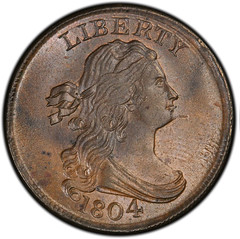
PREV ARTICLE
NEXT ARTICLE
FULL ISSUE
PREV FULL ISSUE
WHAT CONSTITUTES A DIE VARIETY?Last week Bill Eckberg asked: "What Constitutes a Die Variety?
"Personally, I think any alteration has to be significant and not accidental. In the half cent world, the 1795 no-pole obverse is just a reground with-pole obverse that was used earlier. Similarly, the Spiked Chin obverse was apparently the result of some kind of damage. I consider both of those to be die states after their alteration, whether intentional or accidental." Brad Karoleff writes: "My definition of a die "variety" will be different than a die "marriage", which is what I think Bill is talking about here." "A die MARRIAGE is a coin struck from two specific dies IE: Obverse 1 and Reverse A. ANY alteration to either of these two dies when striking a coin from the same two individual dies is a die STATE or STAGE as some are using. If these two dies are taken out of service and used with other dies to make new marriages and in that usage change in characteristics (die clashes, cracks, wear or lapping) and are REUSED in their new states with each other you now have a die REMARRIAGE." "A die VARIETY is somewhat less specific. I define it as a significant deviation from normal. Let's assume in the last instance that obverse die 1 is an overdate. All coins struck using that obverse die no matter the reverse is the overdate VARIETY that can be represented by numerous die MARRIAGES. Now let's assume a reverse die has a blundered denomination. It can be paired with numerous obverse dies to create numerous die MARRIAGES but all are the blundered die VARIETIES." "How about that for muddying the numismatic waters?" Dave Lange writes: "Regarding the definition of a "variety," I prepared several years ago a brief tutorial program addressing this very subject which is now posted at NGC's VarietyPlus website." Thanks, everyone. Here's an excerpt from Dave's explanation. See the complete article online for more. -Editor A variety is a coin that has characteristics specific to the die pair that struck it. Most collectible varieties can thus be traced to a set of dies. There seems to be some confusion as to exactly what constitutes a variety. In United States numismatics, a variety may be defined as a die or die pairing that offers some distinctive feature not a normal part of the design. For early U. S. coins, those made before the introduction of the reducing lathe in 1836, every die required extensive hand punching of letters, numerals and other small features. Therefore, each and every die was distinctive, and each die pairing constitutes a variety. Thus, all coins from this period are of some identifiable variety, and each die pairing may be identified by number under NGC's VarietyPlus service. In the case of modern coins, most features of the design were included in a master hub, from which a series of transfers were made to produce working dies. Very little hand punching was done, aside from the addition of the date and mintmark. Since early in the last century, the date has been an integral part of the master die for each year and has not varied within that year. The same has been true of mintmarks since 1990, and today's coin dies are typically indistinguishable. Though numerous doubled dies, overdates, repunched mintmarks and the like have occurred over the past century, these were the exceptions rather than the rule. Nevertheless, they do qualify as varieties and may be attributed as such under NGC's VarietyPlus service. NGC utilizes numerous other designations that do not, however, constitute varieties. These include designations such as FH for Full Head, FT for Full Torch and FBL for Full Bell Lines. Likewise, the designations BN, RB and RD for Brown, Red-Brown and Red, respectively, are not varieties. NGC does not attribute as varieties coins that display Strike Doubling, Abrasion Doubling, Die Deterioration Doubling, Master Die Doubling (doubling that is found on all coins made produced from that master die), insignificant die chips, breaks, cracks or any variety coin that falls under mint tolerances for doubling or normal die wear. With few exceptions, NGC will not attribute die varieties that require greater than 5x magnification to be clearly recognizable.
To read the complete article, see:
Bill Eckberg adds: "Reading these replies, I realize that I didn't phrase my question very well. What I was trying to get at was, how much difference is required between two coins before we say they were struck from different dies?" Not everyone may agree with NGC's one-size-fits-all definition of requiring greater than 5x magnification to be clearly recognizable, but it's a practical benchmark. -Editor
To read the earlier E-Sylum article, see:

Wayne Homren, Editor The Numismatic Bibliomania Society is a non-profit organization promoting numismatic literature. See our web site at coinbooks.org. To submit items for publication in The E-Sylum, write to the Editor at this address: whomren@gmail.com To subscribe go to: https://my.binhost.com/lists/listinfo/esylum All Rights Reserved. NBS Home Page Contact the NBS webmaster 
|
